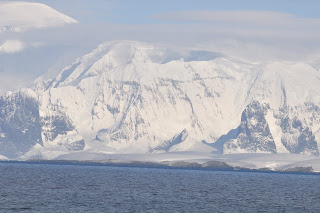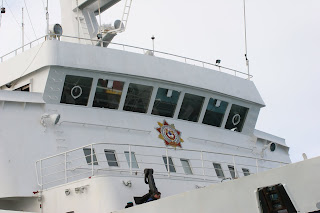
I sit here at my computer wondering how I can possibly describe what we saw yesterday. Our day began with a wake-up announcement over the ship’s loudspeakers that we were about to enter the Lemaire Channel. I could see out our porthole that the sun was just coming up and a few rays were piercing through the snowclouds and painting the icebergs with a rosy glow. I grabbed my pocket camera, slid on my crocs and ran out onto the deck. We have not seen the sun very much since our crossing the Drake Passage so it was a treat to get this nice sunrise. After snapping a few pictures, I went back down to my cabin to see if my SLR camera was working again. It was! Yeah! The camera-in-the-bag-of-rice-trick really worked! We spent the next 3 hours cruising through the Lemaire Channel, a 7 mile long passage that runs between Booth Island and the Antarctic continent. It is 1 mile wide at its broadest point and a half mile at its narrowest point. There were lots of small icebergs in the water which the ship captain had to either navigate around or push aside as we made our way through the channel. Both sides of the channel were flanked with towering peaks nearly 1000 feet high that just seem to explode from the water up to the sky.

Some of the tops we were not able to see due to fog that settled along the peaks. These rocks were covered with glaciers that were nearly at least 100 feet thick. We could see how the ice had compressed over thousands of years and had layer upon layer of sediment mixed with the ice. Some of the glaciers seem to glow an eerie blue as the light made its way through water carved channels and caves that twist through the glacier ice. The temperature was about 34 degrees with a windchill about 10 degrees cooler. Even with all my winter layers on I had to go inside every 20 minutes or so to warm my fingers and toes.

After lunch we reached one of the United States' Antarctica research stations, Palmer Station. The station is home to about 38 scientists and support staff during the austral summer and about 10 staff during the winter. Some of the scientists came on board our ship and gave an overview of their research. The main research done at Palmer is monitoring how the marine ecosystem is responding to changes in sea-ice cover. The glacier is retreating about 10 feet a year, leading to warmer temperatures and less icepack in the water. This is also affecting where the penguins migrate. After their briefing, we made our way onto land via the zodiaks. We were thrilled to see the clouds clearing and a beautiful blue sky emerge. Palmer is nestled at the foot of a huge glacier on a rocky outcrop that looked much like the coast of Maine. Only about 6 ships a year are invited to come and visit the station. The reason for that is that it really takes the entire station staff to support the 100+ visitors.

Staff led tours, manned the souvenir shop (which took credit cards or US dollars), and met with us in their dining hall and offered us home-made brownies (which were yummy). After leaving Palmer, we cruised around the bay in the zodiaks. We made our way through pack ice, circled the huge iceberg in the middle of the bay, and observed an Adelie penguin colony on a nearby island. It was so awesome to see the tops of the mountains which for most of this trip have been covered by fog or not visible due to the driving snow. This was a wonderful last stop before undertaking the 60 hour trip back across the Drake Passage.
We are now heading home and will spend the next 2 days on ship. We will pass the time with lectures on history and wildlife, tours of the ship’s bridge, movies, and of course, eating. Our email accounts will be cut off at 8pm tonight (which is about 6pm EST) so after that, there will be no more blog updates until I reach Argentina on Saturday morning.



.jpg)







